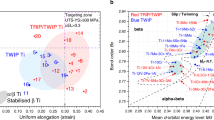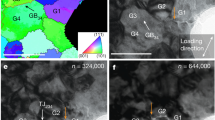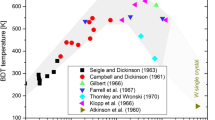Abstract
Crack-tip behaviour in metals is among the most basic problems in mechanics of materials. Yet, long-standing experimental evidence suggests that crack-tip twinning in face-centred-cubic (f.c.c.) metals is highly dependent on the material, temperature and loading rate, and previous simulations and models predict twinning in aluminium, where it has never been observed. Here, this discrepancy between theory and experiment is resolved through a new model guided and validated by extensive multiscale simulations. Both the analytic model and simulations reveal a transition from crack-tip twinning at short times to full dislocation formation at long times. Applied to a host of f.c.c. metals, the model agrees with experimental trends as it predicts large differences in the thermal activation needed for full dislocation emission to dominate. More broadly, this work demonstrates the necessity of multiscale modelling and attention to rate dependence for accurate description of material behaviour and computationally guided material design.
This is a preview of subscription content, access via your institution
Access options
Subscribe to this journal
Receive 12 print issues and online access
$259.00 per year
only $21.58 per issue
Buy this article
- Purchase on Springer Link
- Instant access to full article PDF
Prices may be subject to local taxes which are calculated during checkout





Similar content being viewed by others
References
English, A. T. & Chin, G. Y. On the variation of wire texture with stacking fault energy in f.c.c. metals and alloys. Acta Metall. 13, 1013–1016 (1965).
Venables, J. in Proc. of the Mettallurgical Society Conference Vol. 25 (ed. Reed-Hill, R.) 77–111 (Gordon and Breach Science, New York, 1963).
Adamesku, R., Grebenkin, S., Yermaakov, A. & Panfilov, P. On mechanical twinning in iridium under compression at room temperature. J. Mater. Sci. Lett. 13, 865–867 (1994).
Fortes, M. & Ralph, B. Deformation twinning and double twinning in iridium. J. Less-Common Met. 22, 201–208 (1970).
Blewitt, T. H., Coltman, R. R. & Redman, J. K. Low-temperature deformation of copper single crystals. J. Appl. Phys. 28, 651–660 (1957).
Murr, L. & Esquivel, E. Observations of common microstructural issues associated with dynamic deformation phenomena: Twins, microbands, grain size effects, shear bands, and dynamic recrystallization. J. Mater. Sci. 39, 1153–1168 (2004).
Thornton, P. & Mitchell, T. Deformation twinning in alloys at low temperatures. Phil. Mag. 7, 361–375 (1962).
Haasen, P. Plastic deformation of nickel single crystals at low temperatures. Phil. Mag. 3, 384–418 (1958).
Gray, G. I. & Huang, J. Influence of repeated shock loading on the substructure evolution of 99. 99 wt. percent aluminum. Mater. Sci. Eng. A 145, 21–35 (1991).
Tadmor, E. & Hai, S. A Peierls criterion for the onset of deformation twinning at a crack tip. J. Mech. Phys. Solids 51, 765–793 (2003).
Farkas, D., Duranduru, M., Curtin, W. A. & Ribbens, C. Multiple-dislocation emission from the crack tip in the ductile fracture of Al. Phil. Mag. A 81, 1241–1255 (2001).
Hai, S. & Tadmor, E. B. Deformation twinning at aluminum crack tips. Acta Mater. 51, 117–131 (2003).
Van Swygenhoven, H., Derlet, P. & Froseth, A. Nucleation and propagation of dislocations in nanocrystalline fcc metals. Acta Mater. 54, 1975–1983 (2006).
Zhu, T., Li, J., Samanta, A., Kim, H. G. & Suresh, S. Interfacial plasticity governs strain rate sensitivity and ductility in nanostructured metals. Proc. Natl Acad. Sci. 104, 3031–3036 (2007).
Curtin, W. A., Olmsted, D. L. & Hector, L. G. A predictive mechanism for dynamic strain ageing in aluminium–magnesium alloys. Nature Mater. 5, 875–880 (2006).
Caillard, D. & Martin, J. Thermally Activated Mechanisms in Crystal Plasticity (Pergamon Materials Series, Elsevier, Oxford, 2003).
Rice, J. R. & Beltz, G. E. Activation energy for dislocation nucleation at a crack. J. Mech. Phys. Solids 42, 333–360 (1994).
Hess, B., Thijsse, B. J. & Van der Giessen, E. Molecular dynamics study of dislocation nucleation from a crack tip. Phys. Rev. B 71, 054111 (2005).
Qu, S., Shastry, V., Curtin, W. A. & Miller, R. E. A finite-temperature dynamic coupled atomistic/discrete dislocation method. Model. Simul. Mater. Sci. Eng. 13, 1101–1118 (2005).
Voter, A. F. Parallel replica method for dynamics of infrequent events. Phys. Rev. B 57, R13985–R13988 (1998).
Rice, J. Dislocation nucleation from a crack tip. An analysis based on the Peierls concept. J. Mech. Phys. Solids 40, 239–271 (1992).
Zhu, T., Li, J. & Yip, S. Atomistic study of dislocation loop emission from a crack tip. Phys. Rev. Lett. 93, 025503 (2004).
Hasnaoui, A., Van Swygenhoven, H. & Derlet, P. M. Cooperative processes during plastic deformation in nanocrystalline fcc metals: A molecular dynamics simulation. Phys. Rev. B 66, 184112 (2002).
Meyer, R. & Lewis, L. J. Stacking-fault energies for Ag, Cu, and Ni from empirical tight-binding potentials. Phys. Rev. B 66, 052106 (2002).
Asaro, R. J. & Suresh, S. Mechanistic models for the activation volume and rate sensitivity in metals with nanocrystalline grains and nano-scale twins. Acta Mater. 53, 3369–3382 (2005).
Kumar, K., Van Swygenhoven, H. & Suresh, S. Mechanical behavior of nanocrystalline metals and alloys. Acta Mater. 51, 5743–5774 (2003).
Yamakov, V., Wolf, D., Phillpot, S. R., Mukherjee, A. K. & Gleiter, H. Deformation-mechanism map for nanocrystalline metals by molecular-dynamics simulation. Nature Mater. 3, 43–47 (2004).
Van Swygenhoven, H., Derlet, P. & Froseth, A. Stacking fault energies and slip in nanocrystalline metals. Nature Mater. 3, 399–403 (2004).
Tadmor, E. B. & Bernstein, N. A first-principles measure for the twinnability of FCC metals. J. Mech. Phys. Solids 52, 2507–2519 (2004).
Horstemeyer, M., Baskes, M. & Plimpton, S. Computational nanoscale plasticity simulations using embedded atom potentials. Theory Appl. Fract. Mech. 37, 49–98 (2001).
Ercolessi, F. & Adams, J. B. Interatomic potentials from 1st-principles calculations—the force-matching method. Europhys. Lett. 26, 583–588 (1994).
Sih, G., Paris, P. & Irwin, G. R. On cracks in rectilinearly anisotropic bodies. Int. J. Fract. Mech. 1, 189–203 (1965).
Mishin, Y., Farkas, D., Mehl, M. J. & Papaconstantopoulos, D. A. Interatomic potentials for monoatomic metals from experimental data and ab initio calculations. Phys. Rev. B 59, 3393–3407 (1999).
Bernstein, N. & Tadmor, E. B. Tight-binding calculations of stacking energies and twinnability in fcc metals. Phys. Rev. B 69, 094116 (2004).
Lide, D. (ed.) CRC Handbook of Chemistry and Physics 82nd edn (CRC Press, New York, 2001).
Hirth, J. & Lothe, J. Theory of Dislocations (McGraw-Hill, New York, 1968).
Li, J. AtomEye: An efficient atomistic configuration viewer. Model. Simul. Mater. Sci. Eng. 11, 173–177 (2003).
Acknowledgements
This work was supported by the Office of Naval Research, Materials Research Division, through Grant No. N00014-05-1-0705.
Author information
Authors and Affiliations
Corresponding author
Rights and permissions
About this article
Cite this article
Warner, D., Curtin, W. & Qu, S. Rate dependence of crack-tip processes predicts twinning trends in f.c.c. metals. Nature Mater 6, 876–881 (2007). https://doi.org/10.1038/nmat2030
Received:
Accepted:
Published:
Issue Date:
DOI: https://doi.org/10.1038/nmat2030
This article is cited by
-
Rejuvenation as the origin of planar defects in the CrCoNi medium entropy alloy
Nature Communications (2024)
-
Nanoscale ductile fracture and associated atomistic mechanisms in a body-centered cubic refractory metal
Nature Communications (2023)
-
Atomic mechanism of near threshold fatigue crack growth in vacuum
Nature Communications (2022)
-
High stress twinning in a compositionally complex steel of very high stacking fault energy
Nature Communications (2022)
-
A review on the science of plastic deformation in laser-based additively manufactured steel
Journal of Materials Science (2022)



